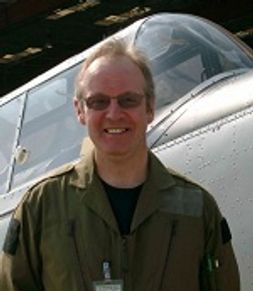About us
Background
In the United Kingdom, the Royal Aeronautical Society recommends the inclusion of practical flight exercises for accredited aerospace engineering programmes to enhance learning and student experience.
The majority of academic institutions teaching aerospace in the UK separate the theory and practice of flight dynamics with students attending a series of lectures sometimes followed by an intensive one-day flight exercise.
To better integrate theory and practice, an innovative, research-led approach has been developed over a 10-year period. Utilising portable Commercial-Off-The-shelf (COTS) and multi-media technologies, has enabled use of a diverse range of standard, unmodified aircraft for the flight exercises.
Over 500 students have completed the practical flight experience in a range of different fixed and rotary-wing aircraft, from classics to modern day trainers.
The integration of theory and practice has enriched learning and teaching, improved coursework grades and the student experience. The use of COTS and unmodified aircraft has reduced costs and enabled wider student participation as student cohorts grow year on year.
Safety is our priority - all of our programmes are delivered by highly experienced ex-military test pilots/qualified flight instructors using aircraft maintained to the UK CAA standards.

the team
Chris Taylor

Chris Taylor a Fellow in the Society of Experimental Test Pilots (SETP) and is at the top of his Test Pilot profession having spent 10 years working for EASA and the UK CAA before becoming established as a successful provider for 5 years of Cat 1 Flight Test services to the Aviation Industry.
Chris completed his Royal Navy Flying Training, being awarded "wings" in May 1983. As top of his class he was specially selected to fly the single pilot Westland Wasp HAS 1 completing his training at RNAS Portland.
In the navy, Chris served as Flight Commander on Wasp and Lynx helicopters. In 1988 he was selected to train as a Qualified Helicopter Instructor at RAF Shawbury which allowed him to return to the Navy as an A2 Instructor and display pilot on the Lynx. Following 2 years running the Simulator Training facility he was selected for test pilot training joining Boscombe Down in January 1994. Later that year Chris graduated top of class and was awarded the coveted Westland Trophy. He then served for 2 years on the Experimental Flying Squadron supporting the research and development trials of RAE Bedford and Farnborough.
Joining the CAA in 2004 Chris worked as an experimental test pilot initially responsible for fixed wing aircraft of all shapes and sizes from business jets down to single seat microlights. Chris completed 10 years as one of the two remaining test pilots being responsible to EASA for a number of key aircraft types. As a Flight Test Instructor he has continued to provide flight test instruction both at home and abroad. To date, Chris has flown over 400 aircraft types/marks.
Dan Griffith

Dan Griffith is Member of the Society of Experimental Test Pilots. He joined the Royal Air Force at 18 and went to London University where he gained a degree in Aeronautical Engineering. He learned to fly on Bulldogs and Jet Provosts before gaining his pilot wings on the Hawk. Dan flew Harriers operationally, gaining over 1200 hours. In 1992 he went to the USAF Test Pilot course at Edwards Air Force Base in the United States, where he spent a year being taught to test all kinds of military and civil aircraft. After Edwards he was posted to the Flight Research site at Bedford and then to Boscombe Down, where his main project was the futuristic fly-by-wire VAAC Harrier developing the next generation of Short Take-off and Vertical Landing aircraft (Joint Strike Fighter).
In 1996 Dan left the military to join the Civil Aviation Authority (CAA). As a civil Test Pilot, Dan was responsible for the Certification and Continued Airworthiness of many types of aircraft ranging from the Airbus A380 to the lighter aircraft, including many LAA types. He left the CAA in March 2007 and now works as an independent test pilot and businessman. Dan has amassed over 6900+ hours flying (2870 test flying) on more than 445 different types/marks, including fighters, airliners, helicopters, gliders, airships, float planes and many LAA Types.
Mike Bromfield
Mike Bromfield

Mike Bromfield is a Senior Member of the Society of Flight Test Engineers, Fellow of the Royal Aeronautical Society and Member of the Chartered Institute of Ergonomics and Human Factors. Mike is a trained flight test engineer (National Test Pilot School. Mojave, USA). He is an Associate Professor in Aerospace/Flight Safety Researcher at a Global Top 100/Russell Group University. A Chartered Engineer and Chartered Ergonomics/Human Factors Specialist gives him unique insight into complex ‘human in the loop’ systems challenges. He received his PhD in Flight Safety/Flying Qualities from Brunel University and completed his BSc in Aeronautical Engineering at the University of Bath in combination with a technologist apprenticeship at Westland Helicopters Limited (now Leonardo), UK. He divides his time between research, consultancy and teaching activities and specialises in human factors, flight dynamics, flight testing, flight simulation/modelling. In 2014, Mike received the LAA Pete Clarke Award for contribution to aviation safety. In the same year he was (jointly) awarded the RAeS Bronze Award for ‘Best Written Journal Paper’. He plays an active role in a number of National, European and International technical and safety committees including UKFSC, NASA TVF, AIAA and EASA. He has over 30 publications.
feedback
Photo Gallery
.
team professional memberships



Copyright © 2024 All Rights Reserved
Flying Classroom® is a Registered Trade Mark